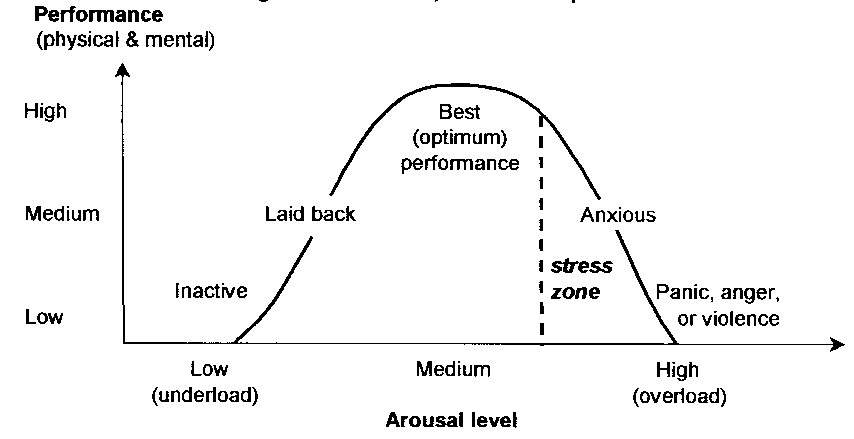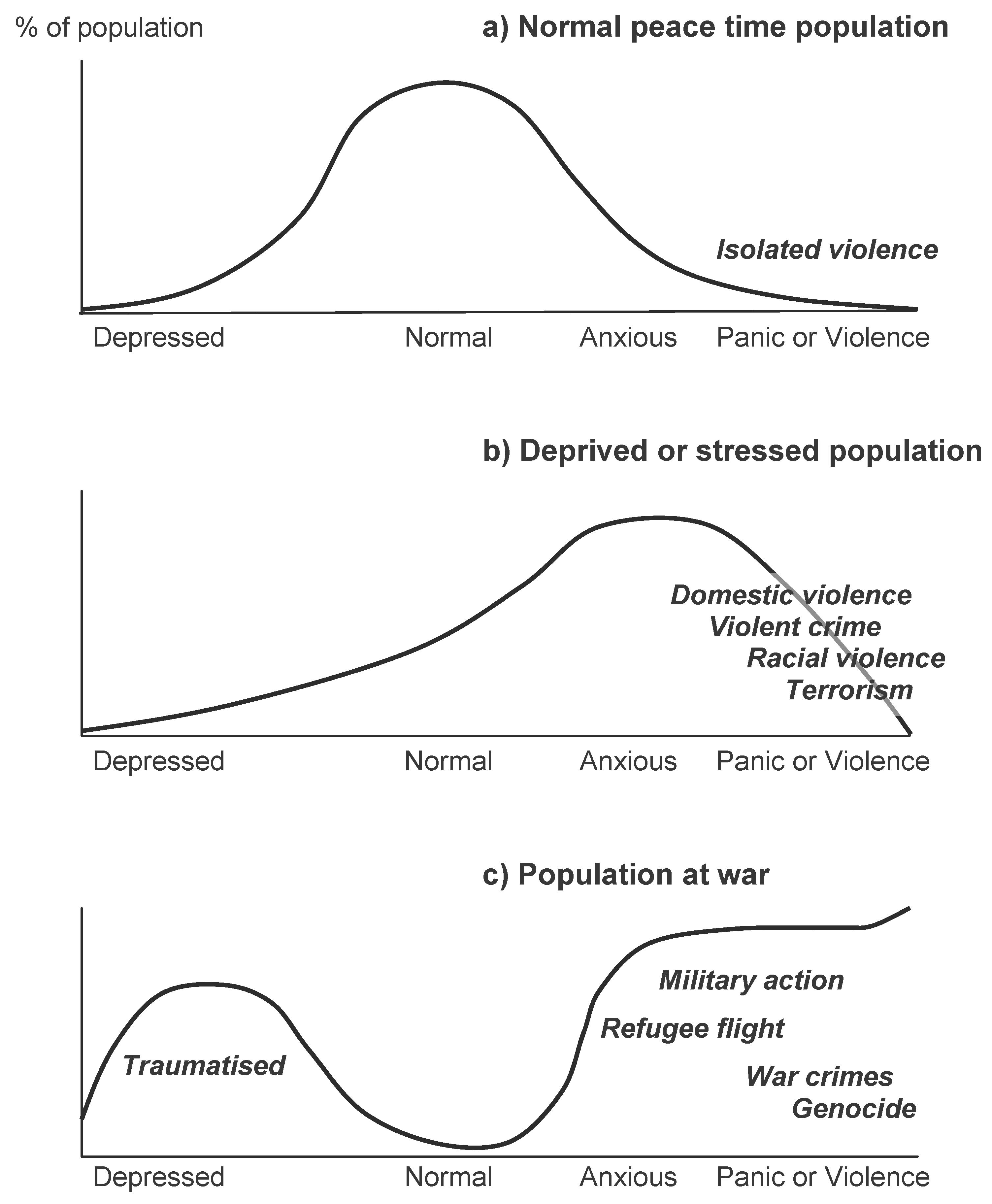
The Eos Life~Work resource centre (page added 27 Nov 2000)
Fear and violence in stressed populations
Stress, violence and peace in the BalkansDai Williams, 27th April 1999
Stress as psychological overload
Definitions of stress vary. In common use there is confusion between stress as a cause of psychological distress, and stress as the effect of psychological overload. People are often described as "under stress", "suffering from stress", "stressed out" etc.
An individual's response to potentially stressful situations varies: the same situation (eg an interview, or doing a parachute jump) may induce stress in one person and be stimulating to another. For practical purposes it is less ambiguous to refer to stress as the response to overload.
Stress arises when the combination of internal and external pressures exceeds the individual's resources to cope with their situation. Stress may develop from chronic (ongoing) or acute (sudden) pressures.
Once stress exceeds the individual's ability to cope it results in a series of dysfunctional physical and mental responses. These can result in temporary or longer-term disruption of health and behaviour, ranging from impaired decision making to Post Traumatic Stress Disorder, and from disturbed digestion to ulcers and heart disease.
These psychological responses are illustrated by the Arousal Curve in Figure 1:
Figure 1: Arousal, stress and performance
Different individuals will be at different starting points on this scale depending on physical fitness and background circumstances. When additional demands are put on them their arousal level will increase e.g. a fit athlete will move from laid back to optimum performance in competition. Fit soldiers will do the same in combat, but if unfit (e.g. hungry) or in fear they will move to panic or violence. A civilian in a war zone will be in a continuous anxiety state, moved to panic or flight under additional threat.
Physical and mental behaviour in the stress zone is determined by the fight or flight response, when threat or fear triggers an adrenaline reaction. Civilised cultures try to suppress the fight response or channel aggression into other activities e.g. sport. But it is latent in most people, restrained only by codes of social behaviour. In war (or criminal) situations these codes and restraints break down, potentially liberating great brutality, or are redefined to make violence a duty.
Political leaders will vary in how well they cope with the additional stress of war depending on their experience. Those who have personally experienced prolonged conflict situations are likely to have well-developed mental strategies for coping with the additional stress of war eg Saddam Hussein and Milosevic.
Those used to more peaceful cultural contexts will have to resolve radical inner contradictions when presented with military or terrorist violence. The first, and probably subsequent exposures, are likely to be quite traumatic, likely to increase their stress. It is likely to take many months to re-adjust mental mind sets appropriately in response to such trauma, usually through the 'transition process' (see Human responses to change ). In the meantime they will be heavily dependent on military advisers who do have combat experience and may be better equipped to stay calm in a period of major crisis.
Fear and violence in stressed populations
At any point in time a community will consist of citizens at range of stress levels. These may be distributed at different points across the Arousal curve, see figure 1.
As general pressures increase on a population - economic, environmental or political - then a greater proportion of individuals are likely to cross the threshold from anxiety to panic or violence see Figure 2:.
Figure 2: Mental health and behaviour in stressed populations: the shift to fear, violence and despair
In Kosovo this increased stress was initiated and sustained by the ethnic cleansing campaign. Fear led to mass panic and hence to the refugee exodus [see footnote for later review].
Increased stress may also account for increased crime and violence in other communities. This occurred in deprived communities in the UK during the recession and violent crime in South Africa. Where a political agenda is used to manipulate increasing levels of stress new policies may actively encourage brutality as in Rwanda and Sierra Leone. "Fighting mad" is an old phrase that warns of mindless violence.
This may partly account for the worse atrocities by Serbian troops in Kosova, and by militia of all parties in earlier Balkan conflicts. Ironically the bombing campaign may have exacerbated the brutality of Serbian troops who may be virtually out of control. [see review]. Nato's hope must be to convert violence to panic, fight to flight (within the Serb forces in Kosova).
Intermittent bombing raids will probably not do this. The prospect of sustained pressure and inevitable defeat through ground forces attack may be more likely to induce flight.
The psychological climate of a community or population determines what percentage of the population may resort to organised or mindless violence. If a population is already stressed every additional source of stress increases the probability and number of individuals that will become violent. For example an individual whose relative has been killed or maimed is more likely to take violent action themselves. This has been found in research into the background of terrorists in Northern Ireland. As these pressures increase then normal social and moral restraints become weaker.
These patterns indicate that violence is a last resort in a stressed population. The existence of violence is a warning that the population is already over-stressed for reasons that are usually obvious.
If violence is the only way to restrain violent individuals or groups it must be very carefully limited. Collateral damage is psychological as well as physical, increasing fear and the potential for anger and violence in a much larger population.
The key task in peacemaking is to reduce and minimise all avoidable sources of stress - military, economic, environmental as well as political.
In the Balkan context this indicates that de-escalating violence is the only measure likely to reduce mass violence or panic. One problem is how to contain the Serbian troops in Kosova. A cease-fire might reduce their extreme stress sufficiently for some to regain contact with reality and realise the futility of their situation. This is used by many police forces to defuse tension when dealing with hostage situations and sieges. By contrast the Waco siege turned into a massacre when pressure was increased.
Psychological global warming
The danger of any international conflict is that it will increase the psychological "temperature" of other countries, especially those with significant communities related to the conflict in question. In effect this is a kind of psychological global warming.
As each community becomes affected by news of conflict a proportion of individuals already on the edge of violence may be moved to take their own violent action, apparently unrelated to the wider conflict. In some cases this may be complicated by increased use of alcohol, in others by the media stirring emotions of patriotism, competition or aggression.
The increase in domestic violence during the Football World Cup and Super Bowl in the US is apparently well recognised by police and hospital services. War on the scale of the current Balkan conflict is likely to have wider impact than sports competitions.
When different forms of tension are occurring in several parts of the world at the same time e.g. the Far East, Middle East, Africa and the Balkans it seems clear that the highest priority on the international agenda must be peace and reconciliation strategies. Enforcement of justice designed for peacetime is of secondary importance where whole populations are involved. Hence South Africa has turned to a reconciliation process instead of seeking retribution for the perpetrators of violence under Apartheid.
Peacebuilding is far more complex than these general issues can indicate. But the psychology of stress and change seems fundamental to understanding and restricting the actions of national leaders in times of tension. And these processes give serious warnings about the risk of increasing, rather than reducing conflict in the Balkans. The alternative is the prospect of multiple conflicts becoming a global conflagration that draws in other countries as it develops.
* * * * *
Footnote
This paper was first written on 27 April 1999 as an Appendix to "Rising global tension: stress, violence and peace in the Balkans". It explored likely psychological effects of stress and change for communities, military forces and governments involved in the Balkans war. This version has been edited for the Eos website in November 2000 focussing on the analysis of likely effects of mass stress. The full version also explained the likely transition effects of recent traumas and changes on the judgement of Nato leaders, excluded here because they are also explained in Human responses to change and Accidents waiting to happen.After this article was written the Kosovan refugee crisis became a major issue in the Balkans war. This was reviewed in section 2 of the follow-up paper Balkans Aftermath: The post-war transition - denial, crisis & world peace published on 9 August 1999.
It appears that Nato seriously under-estimated or mis-calculated the psychological effects of the air-war campaign on Serb troops and Kosovan civilians in April-May 1999 - accelerating both the level of atrocities and scale of refugee exodus anticipated in this analysis. If so this has profound implications for military and peace strategies in other community conflicts e.g. now in Israel in 4th quarter 2000].
Dai Williams, Chartered Occupational Psychologist
Woking, Surrey, UK
Email: eosuk@btinternet.comOther sources
The American Psychological Association has a new Peace Psychology Division, see http://moon.pepperdine.edu/~mstimac/Peace-Psychology.html
In the UK several universities now have departments of Peace or War Studies. Bradford University was the first of these. In Northern Ireland both Queens University and the University of Ulster have done extensive research on community psychology published on the CAIN website (Conflict Archives on the Internet) at http://cain.ulst.ac.uk/index.html.
Many other organisations around the world are involved in research and practical involvement in alternatives to violence for community conflict resolution e.g .
- ICG (The International Crisis Group) in Brussels at: www.crisisweb.org
- The Transnational Foundation for Peace & Future Research in Sweden at http://www.transnational.org/sitemap.htmlCopyright © Eos Career Services 1999, 2000.
Page added 27 November 2000.

